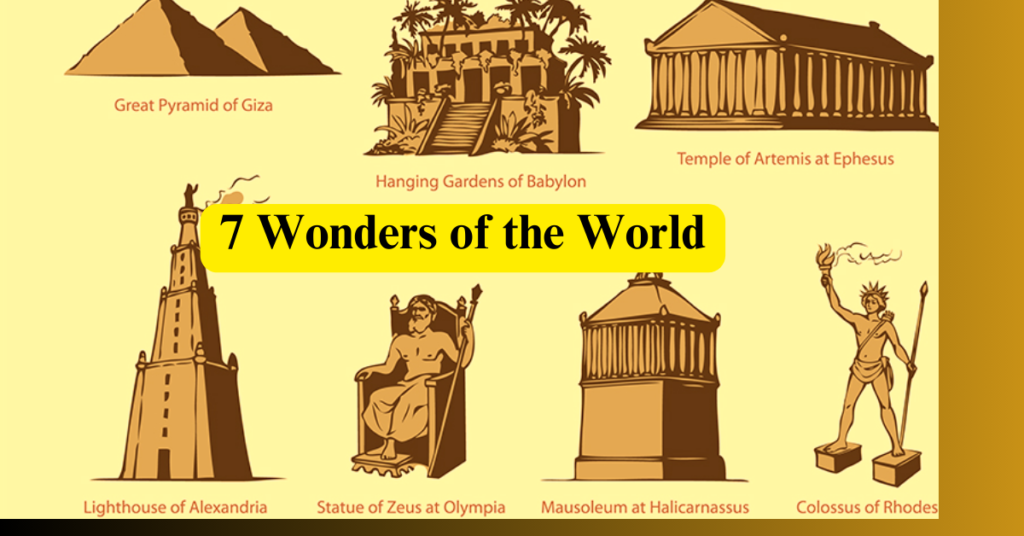
Ancient Marvels to Modern Icons: From Incredible Achievements of the Past to Timeless Symbols of Today
Table of Contents
Exploring the 7 Wonders of the World: From Ancient Marvels to Modern Icons
This article explores both 2 sets of 7 wonders, delving into their history, significance, and lasting impact on human civilization.The 7 Wonders of the World have long fascinated humanity, symbolizing the pinnacle of architectural and artistic achievements across different cultures and eras. These wonders are divided into two categories: the Ancient Wonders and the New Wonders. The former list, originating from Hellenistic travelers, comprises marvels from the classical era, while the latter, a modern reimagining, was decided by a global poll conducted by the New7Wonders Foundation.
The 7 Wonders of the Ancient World
- The Great Pyramid of Giza : The Great Pyramid of Giza is the oldest and the only surviving wonder of the ancient world, representing the architectural prowess of ancient Egypt. Constructed around 2580-2560 BCE for Pharaoh Khufu, this colossal structure stood as the tallest man-made edifice for over 3,800 years. Originally 146.6 meters tall, the pyramid was built using approximately 2.3 million limestone blocks, each weighing between 2.5 and 15 tons. The precision with which these blocks were cut and placed remains a subject of admiration and mystery. The Great Pyramid was part of a complex that included two other large pyramids, smaller pyramids, and the Sphinx, serving as a grand necropolis for the pharaohs.
- The Hanging Gardens of Babylon : The Hanging Gardens of Babylon are shrouded in mystery, with their very existence debated among historians. Allegedly built by King Nebuchadnezzar II around 600 BCE for his homesick wife, Amytis, the gardens were said to have lush vegetation cascading from terraced structures, resembling a green mountain in the arid landscape of Babylon (modern-day Iraq). Ancient writers like Strabo and Philo of Byzantium described an engineering marvel with a complex irrigation system that brought water from the Euphrates River. Despite the lack of archaeological evidence, the legend of the Hanging Gardens continues to captivate the imagination.
- The Statue of Zeus at Olympia : Created by the renowned sculptor Phidias around 435 BCE, the Statue of Zeus at Olympia was a monumental tribute to the king of the Greek gods. Situated in the Temple of Zeus, the statue stood about 12 meters high and was made of ivory and gold-plated bronze. Zeus was depicted seated on a grand throne, holding a statue of Nike in his right hand and a scepter with an eagle in his left. The statue embodied the artistic and religious fervor of ancient Greece and was considered a masterpiece of classical sculpture. It was destroyed during the 5th century CE, likely due to earthquakes or deliberate acts of destruction.
- The Temple of Artemis at Ephesus : The Temple of Artemis at Ephesus, located in modern-day Turkey, was an architectural marvel dedicated to the Greek goddess Artemis. Completed around 550 BCE, this grand temple was built entirely of marble and adorned with intricate sculptures and reliefs. It measured approximately 137 meters in length and 69 meters in width, making it one of the largest temples of the ancient world. The temple served as a religious and commercial hub, attracting pilgrims and merchants from across the Mediterranean. It was destroyed and rebuilt multiple times due to arson, invasion, and natural disasters, with its final destruction occurring in 401 CE by a mob led by St. John Chrysostom.
- The Mausoleum at Halicarnassus : The Mausoleum at Halicarnassus was a grand tomb built for Mausolus, a satrap of the Persian Empire, and his wife, Artemisia II, around 350 BCE in modern-day Bodrum, Turkey. Designed by Greek architects Satyros and Pythius, the mausoleum stood approximately 45 meters high and was adorned with elaborate sculptures by renowned artists such as Scopas and Leochares. The structure combined Greek, Egyptian, and Lycian architectural elements, symbolizing the cultural fusion of the era. Despite being destroyed by successive earthquakes between the 12th and 15th centuries, the Mausoleum’s legacy endures, giving us the term “mausoleum” for grand tombs.
- The Colossus of Rhodes :The Colossus of Rhodes was an immense bronze statue of the sun god Helios, erected around 280 BCE to celebrate the island’s victory over Cyprus. Standing approximately 33 meters high, it was one of the tallest statues of the ancient world and symbolized the resilience and unity of the Rhodian people. Designed by the sculptor Chares of Lindos, the statue was constructed using iron and bronze plates over a framework, and it took 12 years to complete. The Colossus stood for only 54 years before being toppled by an earthquake in 226 BCE. Its remains lay in situ for over 800 years before being sold as scrap metal.
- The Lighthouse of Alexandria (Pharos of Alexandria) : The Lighthouse of Alexandria, also known as the Pharos of Alexandria, was a towering beacon constructed on the small island of Pharos in the 3rd century BCE to guide sailors safely into the bustling harbor of Alexandria, Egypt. Designed by the Greek architect Sostratus of Cnidus, the lighthouse stood between 100 and 130 meters tall, making it one of the tallest man-made structures of its time. Its light, produced by a furnace at the top, could be seen from miles away. The Pharos endured several earthquakes before finally collapsing in the 14th century. Its enduring legacy lives on in the term “pharos,” used to describe lighthouses.
The New 7 Wonders of the World

The New 7 Wonders Foundation announced a list In 2007 of 7 wonders chosen through a global poll. These modern wonders reflect humanity’s ongoing pursuit of architectural and cultural excellence.
- The Great Wall of China : The Great Wall of China is a monumental feat of ancient engineering, stretching over 21,000 kilometers across northern China. Constructed over several dynasties, primarily the Ming Dynasty (1368-1644 CE), the wall served as a defense against invasions and a means of regulating trade along the Silk Road. The wall, built with various materials like stone, brick, tamped earth, and wood, features watchtowers, barracks, and signaling capabilities. Its construction involved the labor of millions of workers over centuries, embodying the enduring strength and resilience of Chinese civilization.
- Petra : Petra, the “Rose City,” is an archaeological wonder located in southern Jordan. Carved into vibrant red sandstone cliffs by the Nabateans around the 3rd century BCE, Petra served as a major trading hub, connecting Arabia, Egypt, and the Mediterranean. The city’s most iconic structure, Al-Khazneh (The Treasury), is a stunning example of rock-cut architecture with intricate facades. Petra’s sophisticated water management system, including dams, cisterns, and aqueducts, allowed it to thrive in the arid desert. Rediscovered in the early 19th century, Petra continues to captivate visitors with its unique beauty and historical significance.
- Christ the Redeemer : Christ the Redeemer, an iconic symbol of Christianity, stands atop Mount Corcovado in Rio de Janeiro, Brazil. Completed in 1931, the statue measures 30 meters in height, with an arm span of 28 meters, and is made of reinforced concrete and soapstone. Designed by Brazilian engineer Heitor da Silva Costa and sculpted by French artist Paul Landowski, Christ the Redeemer overlooks the city with outstretched arms, symbolizing peace and redemption. The statue has become a cultural icon and a major tourist attraction, representing the faith and resilience of the Brazilian people.
- Machu Picchu : Machu Picchu, the “Lost City of the Incas,” is an ancient Incan citadel nestled in the Andes Mountains of Peru. Built in the mid-15th century by Emperor Pachacuti, Machu Picchu was a ceremonial and agricultural center, featuring terraces, temples, and palaces. The site remained hidden from the outside world until its rediscovery by American explorer Hiram Bingham in 1911. Machu Picchu’s remarkable stone construction, blending seamlessly with the rugged landscape, showcases the advanced engineering skills of the Incas. Today, it stands as a testament to the ingenuity and adaptability of this ancient civilization.
- Chichen Itza : Chichen Itza, a major Mayan city in the Yucatan Peninsula of Mexico, flourished between the 9th and 12th centuries CE. The city’s most famous structure, El Castillo (Temple of Kukulcan), is a step pyramid that demonstrates the Mayans’ astronomical and architectural expertise. During the equinoxes, the shadow of the serpent deity Kukulcan appears to descend the pyramid’s steps, a phenomenon attracting countless visitors. Chichen Itza also features the Great Ball Court, the Temple of the Warriors, and the Sacred Cenote, a natural sinkhole used for ceremonial purposes. The site’s rich history and cultural significance continue to draw scholars and tourists alike.
- The Roman Colosseum :The Roman Colosseum, an architectural marvel of ancient Rome, is an enduring symbol of the Roman Empire’s grandeur. Completed in 80 CE under Emperor Titus, the Colosseum could accommodate up to 80,000 spectators who gathered to witness gladiatorial contests, animal hunts, and public spectacles. This massive amphitheater, constructed using concrete and stone, features a complex system of vaults and arches that have withstood the test of time. Despite damage from earthquakes and stone robbers, the Colosseum remains a testament to Roman engineering prowess and continues to attract millions of visitors each year.
- The Taj Mahal : The Taj Mahal, a masterpiece of Mughal architecture, stands as a symbol of love and devotion in Agra, India. Commissioned by Emperor Shah Jahan in 1632 in memory of his beloved wife, Mumtaz Mahal, the mausoleum was completed in 1653. Crafted from white marble and adorned with intricate inlay work of precious stones, the Taj Mahal combines elements of Islamic, Persian, Ottoman, and Indian architectural styles. The central dome, flanked by four minarets, reflects in the tranquil waters of a rectangular pool, creating a breathtaking vista. The Taj Mahal’s timeless beauty and emotional resonance continue to inspire awe and admiration worldwide.
Conclusion
The 7 Wonders of the World, both ancient and modern, showcase humanity’s boundless creativity, ingenuity, and ambition. They remind us of our shared heritage and the diverse cultural achievements that have shaped our history. While the ancient wonders provide a glimpse into the architectural and artistic triumphs of early civilizations, the modern wonders highlight the ongoing pursuit of excellence in the contemporary era. Together, these 7 wonders represent the enduring human spirit and our perpetual quest to leave an indelible mark on the world.


